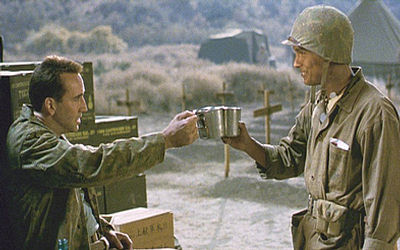




|
8 out of 10 |
 |
|
I`ve seen much in the way of WW2 movies
and history, but who of us in
Canada know quite a lot about the South Pacific theatre of Combat? It was
predominately a USA versus Japan zone of conflict.
Although Germany used
the Enigma Cipher machines, after establsihing a team
of experts, the British managed to break the code, leaving the Allies able
to intercept and read the German communications. Fully knowing that the
enemies intentions is a distinct military tactical advantage. John Woo`s
"Windtalkers" provides us with some little known facts about successful
military codes: the Japanese also managed to break many US scret codes with
success until the Navajo twarted them.
US Marines enlisted and recruited Navajo,
bussing them right off Arizona
reservations. The Navajo entered military life, specifically being trained
in code usage where native short forms were used, eg "Many Big Guns" meant
"Artillery". Trained as radio operators, they could transmit in seconds
what had previously taken minutes. Although the Japanese intercepted these
new signals, they couldn`t understand and decipher their meaning. Navajo
language mixed with Indian code words became a double-edged sword, for the
US Supreme Command worried that the Japs would break the code and "Protect
the code at all costs", became the rule of the day.
During the battle of the Solomans,
an acting NCO stood Nicholas Cage, and
his platoon stood and fought the Japanese down to the very last man.
Nicholas Cage`s character next finds himself back in Hawaii, recovering
from his wounds.
Refusing to be discharged
from military service, he volunteers for active
duty. Promoted to the rank of sergeant, his job becomes "Protect the
Code". Paired with one of the Navajo Radio Operators, they are both sent
off to combat in the 1944 Naval Invasion and Battle for Saipan, which the
USA wants as a B29 Superfortress emergency landing and refueling base for
attacks against the Japanese homeland.
Navajo radio operators
were responsible for laying down and communicating
back effective fire missions. The Naval bombardment scenes were well
filmed and exciting. The aircraft were not that historically accurate,
because aircraft pictured were too modern.
US Marines were to protect
their Navajo radio operator`s counterparts.
Although being distant at first, they developed quite close friendships,
but never were the Navajo to be captured by the enemy and risk their
torture by the Japanese that might lead the Japanese to break the code.
War is cruel,
and it is hard to kill a friend. Combat turns into kill or
be killed with John Woo style showing in the violent combat, like it was
historical, each side never giving an inch with bitter hand-to-hand
fighting and death at close range. Who reacted and shot first was often
the onlyone left. Fast combat close-ups means deaths were a blury sequence
of events.
Overall a good flick
telling a little known story of the Navajo Code
Talkers and in the end, the only one that the Japanese never succeeded in
breaking.
Film Critic: Paul Wieler |
|